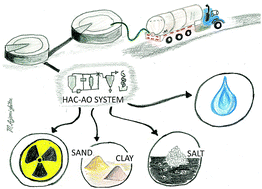Raw material recovery from hydraulic fracturing residual solid waste with implications for sustainability and radioactive waste disposal†
Abstract
Unconventional oil and gas residual solid wastes are generally disposed in municipal waste landfills (RCRA Subtitle D), but they contain valuable raw materials such as proppant sands. A novel process for recovering raw materials from hydraulic fracturing residual waste is presented. Specifically, a novel hydroacoustic cavitation system, combined with physical separation devices, can create a distinct stream of highly concentrated sand, and another distinct stream of clay from the residual solid waste by the dispersive energy of cavitation conjoined with ultrasonics, ozone and hydrogen peroxide. This combination cleaned the sand grains, by removing previously aggregated clays and residues from the sand surfaces. When these unit operations were followed by a hydrocyclone and spiral, the solids could be separated by particle size, yielding primarily cleaned sand in one flow stream; clays and fine particles in another; and silts in yet a third stream. Consequently, the separation of particle sizes also affected radium distribution – the sand grains had low radium activities, as lows as 0.207 Bq g−1 (5.6 pCi g−1). In contrast, the clays had elevated radium activities, as high as 1.85–3.7 Bq g−1 (50–100 pCi g−1) – and much of this radium was affiliated with organics and salts that could be separated from the clays. We propose that the reclaimed sand could be reused as hydraulic fracturing proppant. The separation of sand from silt and clay could reduce the volume and radium masses of wastes that are disposed in landfills. This could represent a significant savings to facilities handling oil and gas waste, as much as $100 000–300 000 per year. Disposing the radium-enriched salts and organics downhole will mitigate radium release to the surface. Additionally, the reclaimed sand could have market value, and this could represent as much as a third of the cost savings. Tests that employed the toxicity characteristic leaching protocol (TCLP) on these separated solids streams determined that this novel treatment diminished the risk of radium mobility for the reclaimed sand, clays or disposed material, rendering them better suited for landfilling.

- This article is part of the themed collection: The environmental geochemistry and biology of hydraulic fracturing


 Please wait while we load your content...
Please wait while we load your content...
